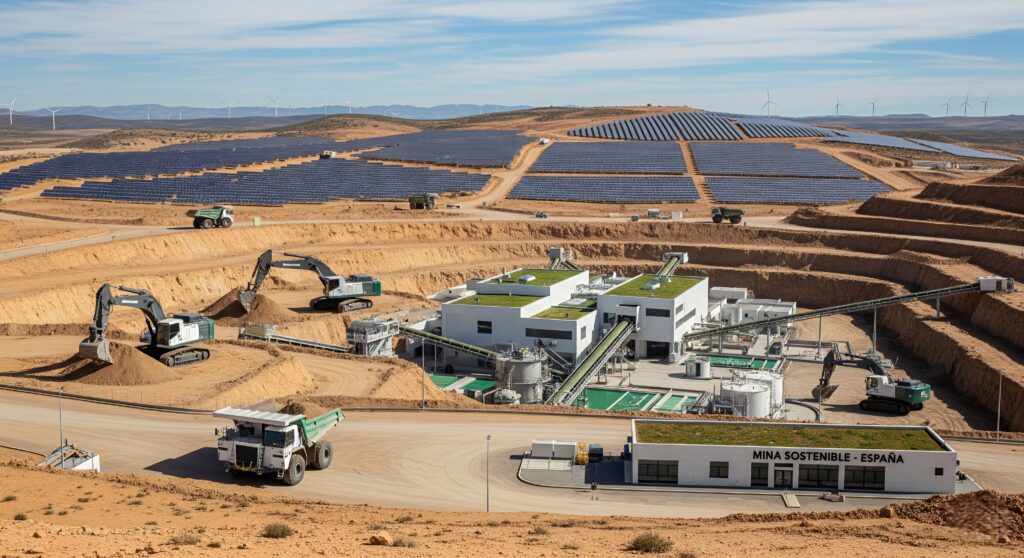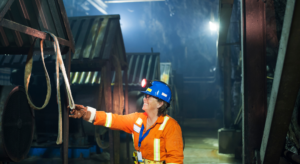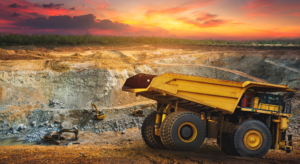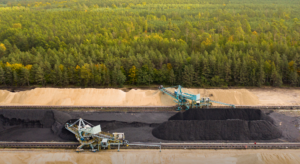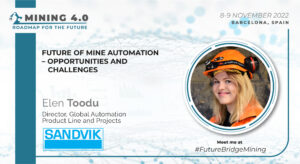If you’re following the news, you’ll be familiar with the new Spain Mining Law updates and the way the EU’s Critical Raw Materials Act (CRMA) is setting the continent’s trajectory. But do you know that Spain’s national action plan is the on-the-ground policy blueprint on how they’re going to make it happen? It’s not just another policy document. Instead, it is a visionary appeal for investment & innovation, converting vague European desires into tangible schemes/ legal changes/ budget incentives. This article breaks down the three pillars at the center of Spanish strategy. It explains precisely how Spain seeks to become a keystone of Europe’s raw materials security and what business opportunities this creates.
Unlocking New Resources: Spain’s Strategy for Exploration and the Circular Economy
Spain is not merely sitting on a pot of undiscovered minerals. It is, in fact, creating avenues to discover/recover them. This part of the plan is more about expanding the nation’s self-reliance on resources from two different sides: looking deep into the earth and sorting through what has already been tapped. So, this part will examine the specific programs/ budgets that Spain is undertaking to find new deposits and turn yesterday’s waste into today’s treasure:
The National Mining Exploration Programme: Mapping Spain’s Untapped Potential
Spain is embarking on a nationwide hunt for minerals for the first time since the 1970s. It is far from a casual survey. Instead, it stands to be a high-tech, systematic process for charting the country’s mineral wealth. Furthermore, the government is using everything from advanced satellite imagery to seismometers & AI-driven data analysis. This is to uncover potential deposits of Critical Raw Materials Spain needs. It includes lithium/ cobalt/ rare earths. Moreover, take it as a futuristic treasure map that has the backing of hard science. For businesses, the program reduces the risk of the initial, and generally most expensive, phase of exploration. The open data will also bring tremendous benefit to businesses by pointing them in the direction of high potential and reducing the guesswork/ up-front cost of finding potential areas to mine. This is among the key provisions of the new Spain Mining Law.
Urban Mining: How the Plan Incentivizes Metal Recovery from Landfills and Tailings
Spain is serious about utilizing its waste as an asset. The strategy gives strong financial incentives for firms that can extract metals from old dumpsites, industrial slag piles, and mine waste. This is where “urban mining” plays a role. The government’s also giving out grants and tax incentives for tech that helps recover materials more efficiently. This includes things like copper, zinc, and even precious metals from recycled sources. For instance, a business that has developed a new hydrometallurgical technology able to extract cobalt from vintage electronic waste might be provided with substantial investment. Not only does this remediate historical environmental sites, but it also opens up a new, national source of Critical Raw Materials Spain without opening a new hole. As a result, it is a win-win that the Spain Mining Law comprehensively embraces.
Digital Product Passports: Spain’s Approach to Enforcing Material Traceability
Gear up for a new era of transparency. Spain is introducing the Digital Product Passports system. It stands to be a key part of its circular economy ambitions under the new Spain Mining Law. Here’s the deal: For products like EV batteries or wind turbines, a digital record will track every critical raw material used, from when it’s first discovered to when it’s disposed of. When a battery reaches the end of its life, recyclers can check its “passport”. It helps to find out what materials are inside, including the amount of cobalt, lithium, & nickel. This makes recovery that much more efficient. Additionally, this mandate is a big opportunity for tech companies to develop the blockchain-based software & tracking systems needed to manage these passports. It also makes producers responsible for the complete life cycle of their products. So, this pushes them to innovate in recycling.
The €400 Million Fund: Accessing Capital for Land Rehabilitation and Resource Recovery Projects
Spain kick-starts this circular economy push by allocating a €400 million fund for initiatives where ecological clean-up/ resource recuperation converge. This is a first for Spanish Mining Investment. A company can, for instance, propose a project to restore a defunct tailings dam in the Andalusia area. The project would not only extract remaining valuable minerals but also treat the land, making it stable and secure. Moreover, the firms can approach this capital to fund:
- The expenses of new equipment,
- Technology fees,
- And operational expenses.
The government is also rewarding projects that give the greatest combination of economic return/environmental improvement. As a result, it is generating an effective incentive for innovation within the recycling and remediation industries. This fund is a real application of the new Spain Mining Law.
Modernizing the Framework: Navigating Spain’s New Mining Laws and Permitting
Spain recognizes that ambitious objectives require a new, effective rulebook. Much of the action plan involves a total rewriting of its decades-long regulations. It aims to reduce red tape, offer clarity to investors, and make sure projects are the highest environmental standards possible. So, this section explores the essential legal and bureaucratic reforms that will shape the future of Spanish Mining Investment:
Overhauling the 1973 Mining Law: What’s Changing for Environmental and Social Governance (ESG)
The old Spain Mining Law from 1973 is getting a 21st-century upgrade. Spain’s new mining law makes ESG the starting point. Companies now have to meet with local communities from the beginning & show exactly how people nearby will benefit, whether through jobs or better infrastructure. Meanwhile, the law raises the bar on environmental care. This is with strict rules for water use/ protecting biodiversity. Additionally, getting a permit now depends on how well a project handles these issues. A company that builds a mine with less environmental damage & strong local support will move through the approval process more easily. As a result, ESG is now a core part of mining in Spain.
The “Strategic Project” Designation in Practice: A Look at Spain’s Fast-Tracked Lithium and Tungsten Sites
If you wish to learn how to get a mining permit in Spain quickly, this is the way. The proposal creates a “Strategic Project” designation for activities critical to Europe’s supply chain of Critical Raw Materials Spain. Furthermore, projects that receive this classification are fast-tracked, with the deadlines for permits reduced dramatically. This is already in practice. A large lithium project in Extremadura and a tungsten mine in Castile and León have both been given this designation. This enables them to avoid years of possible delay and edge closer to construction. Moreover, for investors, this is a degree of certainty that was previously nonexistent in the European mining industry. So, this is making a strong impact on Spanish Mining Investment.
A Single Point of Contact: How Regional Authorities are Streamlining Bureaucracy for Investors
One of the greatest pains for mining investors has been to navigate a complex series of various regional/ national authorities. The new action plan, a central feature of the revised Spain Mining Law, corrects that. All of Spain’s autonomous communities will have an office with a “single point of contact” to shepherd mining investors through the whole process. Furthermore, the office will oversee all the permits involved, environmental impact studies, through land use permissions. This is so that applications don’t disappear in red tape. Additionally, this streamlined process makes the task of determining how to obtain a mining license in Spain much clearer and certain. That too, without costing companies time & legal fees.
Water Usage Regulations: Tackling Scarcity with New Mandates for Mining Operations
In a water-short nation such as Spain, mining’s water use is under the spotlight. The new Spain Mining Law brings some of the toughest water rules in Europe. Moreover, new mines are now compelled to have closed-loop water systems. This means recycling and reusing the overwhelming majority of the water they use. The strategy also encourages the use of “dry stacking” tailings technology that eliminates the need for huge water-filled lakes. For technology companies, this spells a lucrative market in:
- High-end water filtration,
- Recycling equipment,
- And water-free processing technologies.
For mining companies, putting money into this technology is becoming an unquestionable prerequisite for project approval.
Building the Value Chain: Fostering Investment in Domestic Processing and Technology
Discovering & extracting minerals is just half the equation. Spain’s action plan makes a strong effort at constructing the whole value chain locally. This covers everything from processing raw ores into pure metals to creating the next generation of mining professionals. So, this part explains the fiscal/ structural aid being implemented to allow value from Spain’s resources to remain within Spain. This is an important aspect of the Spain Mineral Raw Materials Action Plan 2025-2029 details:
Tax Incentives for New Refineries: Bolstering Spain’s Processing Capacity
To achieve the EU goal of processing 40% of its own strategic minerals, Spain is extending its welcome mat to refineries. Furthermore, the action plan involves substantial tax rebates for firms that construct new processing plants in the country. We are not talking about marginal tax relief here. We are speaking of huge cuts in corporate taxes for the first few years of production and accelerated depreciation for new machinery. This makes the economics of constructing a lithium hydroxide plant or a refinery for rare earth elements in Spain much more compelling than anywhere else. Additionally, this is one of the most significant Spain Mineral Raw Materials Action Plan 2025-2029 details points for downstream companies.
Public-Private Partnerships: The Role of Universities and Tech Centers in Developing New Extraction Technologies
Spain is supporting an impressive collaboration among industry, government, and academia. The plan establishes a set of public-private partnerships dedicated to addressing essential technological issues in mining. For instance, the chemical engineering department at a top Spanish university can collaborate with a top mining firm to test a new, cleaner way of extracting metals. Additionally, the government will invest in co-funding for research and development. This lowers the risk for the firm. Additionally, this is a pipeline of innovation; Spain, instead of being merely an exporter of raw material, is also becoming a center of advanced mining technology.
The Iberian Pyrite Belt Initiative: Cross-Border Collaboration with Portugal for Copper and Zinc
Aware that geology does not know borders, the strategy features a dedicated project for the Iberian Pyrite Belt. It is a huge mineral-rich area that it shares with Portugal. This presents interesting investment prospects in the Iberian Pyrite Belt. Moreover, Spain and Portugal are aligning their regulations and infrastructure development to form a borderless, seamless cross-border mining cluster. This would imply that a mine on the Spanish side could send its ore more conveniently to a processing plant in Portugal, and vice versa. Additionally, this cooperation makes the whole region more appealing for massive Spanish Mining Investment in base metals such as copper and zinc. These are also the type of investment opportunities in the Iberian Pyrite Belt that investors are seeking.
Workforce Development: National Training Programs for the Next Generation of Geologists and Engineers
You can’t have a mining boom without the necessary people. The last element in the equation is a considerable investment in human capital. The action plan is financing new specialized studies at Spanish universities & vocational centers to train the next generation of geologists, mining engineers, and data scientists. It also encompasses plans to upskill the current workforce, with training modules on automation, drone flying, and digital mine management. Furthermore, this will see to it that as the industry changes, there will be a continuous supply of talented local people. This is to man the high-tech jobs being produced, another pillar of the new Spain Mining Law.
To Wrap Up
Spain’s Action Plan is a bold & unequivocal step towards converting its geologically rich potential into a strategic industrial strength. Additionally, Spain is positioning itself to achieve/ surpass the CRMA’s 2030 goals. This is through three different pillars, like unlocking the new & secondary resources, making the legal/regulatory framework modern, and taking an active part in building its domestic processing value chain. So, this is not just a compliance exercise. It is a strong industrial strategy aimed at drawing investment, driving innovation, and securing a top spot in the green and digital future of Europe.
Companies across Europe are hearing the message: now’s the time to get involved in Spain’s mining industry. If you want to connect with the people leading the charge, don’t miss the 8th Mining 4.0 Europe: Roadmap For The Future event in Barcelona on 6-7 November 2025.

